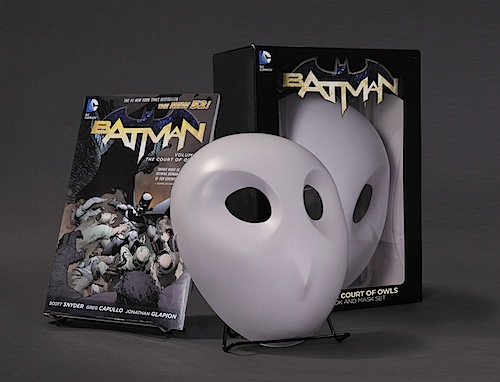ICv2 reports on Overstock.com’s price war with Amazon. Basically the online retailer is matching Amazon’s deep discounts on books—despite losing money on these discounts—in an effort to become more of an alternative to Amazon.
In a statement that could presage future attempts to grab sales from Amazon, Overstock’s CEO Patrick Byrne told The Wall Street Journal, “We think with the rise in sales volume, we can extract better pricing from publishers. Publishers do want to see more competition for Amazon.” While matching Amazon’s current prices might be a solid first step on Overstock’s plan to carve out more of the online book trade, it is difficult to see how the challenger expects to change the buying habits of Amazon’s customers by simply matching its prices.
But the buyer is the winner in all this, as some representative prices reveal:
The Walking Dead Compendium Vol. 1, ($59.99 MSRP), which was (during the sale) going for $23.93 on Overstock and $26.59 on Amazon is now selling for $29.63 on both sites, while the Batman: The Court of Owls Book and Mask Set (MSRP $24.99) was selling for $7.54 (70% off) on Overstock and $10.49 on Amazon, is now going for $14.99 on both sites. The Complete Calvin & Hobbes paperback ($100 MSRP), which was $50.73 on Amazon, and $45.66 on Overstock, is now $53.85 on both sites.
Book publishers might welcome an alternative to the increasingly powerful Amazon, but if everyone has to lose money to do it, it’s still not an ideal situation.









This is going to be a tough strategy for Overstock to pull off. As ICV2 rightly points out, you have to do more than just match Amazon to get people to switch. as an Amazon Prime subscriber, I’m going to need free shipping and consistently MORE than 10% below Amazon prices before i’m going to bother checking another URL.
as a consumer tho, its certainly not bad news. this kind of competition can only help.
Will be interesting to see how payments to publishers go on these as well. Sure, it’s great to sell more of a sixty dollar book, but not if you’re getting substantially less than the sub-30 bucks you’re making as a wholesale price.
It will be easier to match or beat Amazon’s prices now than it would have been a year ago. They have reduced the discounts on graphic novels considerably, usually only about 25% off. I went from a frequent Amazon customer to rarely ordering there. After a quick review of my Amazon history, I see I haven’t ordered a book from them since March.
The hefty discounts are at DCBS/InStockTrades, CheapGraphicNovels.com, TFAW, Tales of Wonder, and a few other specialized comic sellers.
The online aftermarket for print comics is pretty dead. Selling chunks of my own collection (not generic crapolla from the 90s either) has been slow going and low paying.
I can’t imagine how small the margin must be for these online stores like DCBS between the discount they give on MSRP and the shipping costs. Frankly I’m surprised the shipping costs alone aren’t keeping them in the red, and that’s with using the cheapest options like media mail.
They’ve got to be cash poor. Wonder how many of them will disappear after just one bad year?
I have to think with DCBS that some of the big discounts are loss leaders and they’re hoping people will add some more reasonably priced TPBs with the 1/2 off omnibus they order.
There is an example of the opposite happening:
A used book retailer set up an algorithm to price rare copies a few dollars more than other online retailers.
Problem was, another used book retailer did the same thing.
I believe the price went to four digits before either retailer realized what was happening.
Publishers (or in Diamond’s case, distributors) get their money. They are not losing any money on this, UNLESS they offer a co-op discount to cover part of the discount.
Thanks to Herbert Haft, Dart Drug, and Super Crown Books (from which Amazon stole their business plan), retailers can price merchandise however they want, even if they lose money. (Dart Drug Corporation v. Parke Davis & Company)
Super Crown discounted EVERYTHING in the store, from 10% for magazines and paperbacks all the way up to 40% for bestselling hardcovers. Margins might be slim, but with returnability and volume, they managed to make a profit.
For comics shops doing business via Diamond, discounts vary by publisher and volume.
http://retailer.diamondcomics.com/support/retailer_docs/newaccts/diamondtos.pdf
DC:
” DC Comics Discount DC Retail Products Discount
$0-$999 ……………………………………..35%…………………………………………35%
$1000-$2,999………………………………50%…………………………………………45%
$3000-$4499 ………………………………53%…………………………………………45%
$4500-$16,999…………………………….55%…………………………………………45%
$17,000-$34,999 …………………………56%…………………………………………45%
$35,000+ ……………………………………57%…………………………………………45%”
Marvel:
“12-Month Average Standard
Invoiced Orders Discount
$0-$799…………………………….35%
$800-$1,199 ……………………..45%
$1,200-$2,499……………………50%
$2,500-$3,999……………………53%
$4,000-$6,999……………………54%
$7,000-$14,999………………….55%
$15,000-$29,999………………..56%
$30,000-$74,999………………..57%
$75,000-$124,999………………58%
$125,000+…………………………59%”
Dark Horse: matches Diamond’s standard discount.
“● The maximum discount for limited-edition, signed hardcovers is 42.5%.
● The maximum discount for model kits and painted figurines is 50%.
● The maximum discount on Dark Horse’s graphic novels and trade paperbacks is 52.5%.”
Image:
“Monthly Image Retail Discount
$425-$1,149 ……………………….35%
$1,150-2,199 ……………………..45%
$2,200-$6,299 ……………………50%
$6,300-$9,999……………………52.5%
$10,000-$49,999 ………………..55%
$50,000-$94,999 ………………..56%
$95,000-$269,999 ………………57%
$270,000+…………………………57.5%”
Chains can group their orders for better discounts.
(One more reason for stores to have a digital storefront.)
If they lump their orders, they more easily qualify for variant covers and discount incentives.
Note, too, that by increasing orders (as with the recent variant discussion), retailers can increase their discounts. (For example, with Image, a store will be charged $1879.53 for $3999 of product, but only $1840 for $4000. (A savings of $39.53 .) [I’ll let Brian Hibbs better explain discounts and points.]
Libraries can order direct from Diamond at these terms:
“25% off Retail Price
Add 5% of Retail for Shipping & Handling
Add Applicable Taxes, if any”
(Pretty crappy, since most library distributors will offer a discount of 40-50%, since libraries order books on a non-returnable basis.)
Sorry about the formatting…
Here’s DC:
DC Comics DC Retail Products
Discount Discount
$0-$999 …35%…35%
$1000-$2,999…50%…45%
$3000-$4499 …53%…45%
$4500-$16,999…55%…45%
$17,000-$34,999 …56%…45%
$35,000+ …57%…45%
That is why my library is switching from ordering from Amazon to DCBS.
Comments are closed.